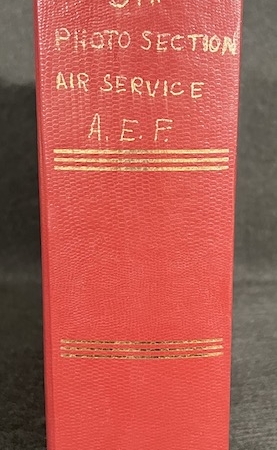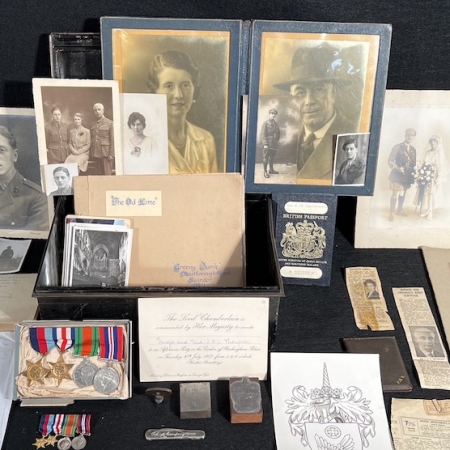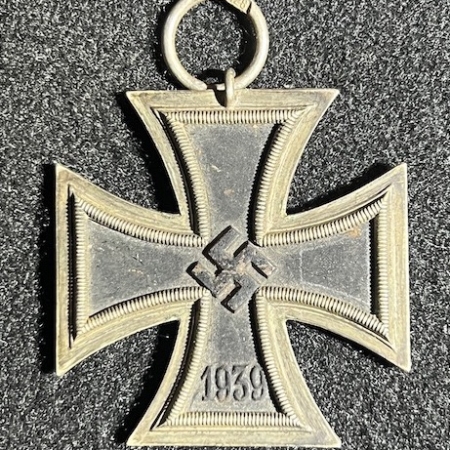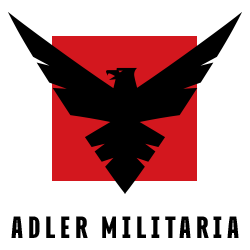Showing 235–243 of 1093 resultsSorted by latest
-

GRAPHIC WWI US 5th Photo Section Air Service American Expeditionary Forces A.E.F Original Photo Album France 1918 Red Barron Fokker
An Incredible pictorial history of the 5th Photo Section Air Service the album owner seems to be “Pops” Reynolds. They flew Recon Missions in France in 1918 under the Aero XIII C.A (see photo of Recon on 16 May 1918) Many of the photos are noted on the rear and have an array of different content, I was unable to find much information even on this unit. Many photos show the daily life of the Section and include two interesting photos of personalities – Captain Adams, and Lt Esley. Both seem to be leading the Photo Section. Interestingly there are photos of many different aircraft including, Handley Page During the First World War, Handley Page produced a series of heavy bombers for the Royal Navy to bomb the German Zeppelin yards, with the ultimate intent of bombing Berlin in revenge for the Zeppelin attacks on London. Handley Page had been asked by the Admiralty to produce a “bloody paralyser of an aeroplane”.[citation needed] These aircraft included the O/100 of 1915, the O/400 of 1918 and the four-engined V/1500 with the range to reach Berlin. The V/1500 had only just entered operational service as the war ended in 1918. General Liggett Lieutenant General Hunter Liggett (March 21, 1857 − December 30, 1935) was a senior United States Army officer. His 42 years of military service spanned the period from the Indian campaigns to the trench warfare of World War I. Additionally, he also identified possible invasion sites in Luzon, particularly Lingayen Gulf, which were used during World War II in 1941 by the Japanese and in 1945 by the United States. Scrapped German Planes, D211 – Paris on Display, Major Andersons Crash at at Quiches. Flying Fish Field. Wreckage of a German Armoured Plane November 1918. Dead German Soldier with Helmet next to him. Dead german Soldier with Gas Mask on his Chest Noted – Dead Boche in the Argonne) . Gas Attack . Camouflaged Observation Ballon near Verdun. Boche Plane Brought Down. Americans Collecting German Spiked Helmets. Dug Outs in the Argonne. Chateau de Chehery. A large photo album from WWI are hard to find, but his is an exceptional find and would be great for further research or study. This is a museum grade archive of the 5th Photo Section.
-

WWI US Army Grouping – (GRAPHIC) – Corpsman Walther R Kooser – With Period Maps – Original Album / Photos – Rare
An interesting Grouping to a US Service man called Corpsman Walther R Kooser Super period large maps of the battlefield, many are marked and places highlighted. Interestingly there are German Items with dirt on them, clearly he lifted them from the battlefield. A rather large grouping but compact in the box it sat in for over 100 years. Many pictures are graphic, including photos of Dead German Soldiers and even a Gas Attack. Feel Free to make us an Offer
-

WWI / WWII British Army Officers Medal Grouping – Major J.B.L Thompson – Royal Engineers – Buckingham Palace Invite 1952 – Family Seal
This is an interesting little tin of memories, it include fine made silver items. As well as a wonderful pictorial history of the Father and Son during both WWI / WWII. This is an interesting find with the Medals and matching Mini set. Seems the son was in Europe at their Uncles grave in France November 1944. Sadly there is not much in terms of research but its clear both Father and Son served. Nice set as its unusual.
-

-

WWII German Iron Cross Second Class – 128 – Firma S. Jablonski & Co. GmbH Posen Poland – Rare EK2 Maker Sold
Seems to be one of the harder ones to find.
-

WWI & WWII US Navy Officers Grouping – Lt Commander Herbert P Bearce – Inscribed US Navy Officers Sword – Rare
Grouping to Herbert P Bearce It seems Bearce did considerable travelling to South America in the period after the First World War, his passports are filled with entries, as well as his Mothers and his Wife. Bearce served in WWI in the US Navy, but by 1930 he would join the US Cavalry as a Captain, by the end of WWII he was in the Pacific but this time back in the US Navy. Quite an unusual career, he had a large family with a member with his wife who he met in South America. I have found his name on various ancestry records, but one mentioned 1941 he is stationed in the US Navy in Washington DC. But another shows that in 1925 he was unboard the USS Utah. His wife, child of Louise Osbaldeston VESLY, namely an Alexandra DE VESELY. Alexandra seems to have married a Herbert Potter BEARCE, and in 1937 they announced the birth of a son in the New York Times. The child is described in the birth announcement as a “great-grandson of the late Lord Edwin Osbaldeston, surgeon to Queen Victoria“.. (It also describes Alexandra as “the former Miss Alexandra de Vesely of Vienna” – not clear whether this is Vienna, N.Y. or the Austrian Vienna). Most of the paperwork included are in relation to Alexandra, and their children. Bearce lost a Son in the Vietnam War (Larned Vesely “Reb” Bearce) a Major in the USMC, he was one of the last casualties of the Vietnam War. The letter informing his parents is in the grouping. See more here: https://www.findagrave.com/memorial/143261185/larned-vesely-bearce Bearce finished a book published shortly after the death of his son, titled, Magic of the Mind (See Photos). His USN Naval Officers Dress Sword, Belt and Hanger are in good collecting condition, the sword is inscribed with his name, and his dress tunic displays a wonderful hand made insignia of the USN. The tunic is named on the collar to Bearce. Minimal damage, a few missing buttons. An interesting grouping, and surely worth further research.
-

WWII German M40 Helmet – Textured Camo Helmet – Complete with Untouched Liner
This helmet seems to have been repainted with texture during the war, ghosting of a decal and a complete liner with chin strap complete this. Please note: The light in the images is a bit brighter in order to see the Camo and details, it is a bit darker in hand. A nice solid Combat Veteran, which the liner was never removed or flipped. Sadly we are unable to see any markings due to the textured Camo thickness.
-

WWII US Navy M1 Helmet – Navy Cross Lt Commander Amos Hathaway – Taffy 3 – Destroyer U.S.S. HEERMANN (DD-532) – Battle off Samar Island 1944 – Very Rare
An Incredible US M1 Helmet from one of the most amazing battles in the Oceans during the war, US Navy Taffy 3 was out gunned but they put up a fight that would go down in Navy History as a battle with all odds against the US Navy.
-

WWII Original SA Dagger Full Rohm Inscription and with Hanger – In Herzlicher Freundschaft Ernst Röhm – US Army GI Bring Back – Rare (Sold)
An original and very nice condition SA Dagger, made by “Carl Eichhorn, Solingen” Motto is complete and is extremely hard to find : In Herzlicher Freundschaft Ernst Röhm Marked on the Cross-guard for SA Gruppemark “Nrh” ( Niederhein) After the Night of the Long Knifes (See our Newspaper for that day in Berlin 1934) these incriptions were removed, 90% of the ones found have this inscription removed. Price includes shipping World Wide Tracked, Guaranteed Original and was a Bring Back from a US GI.




